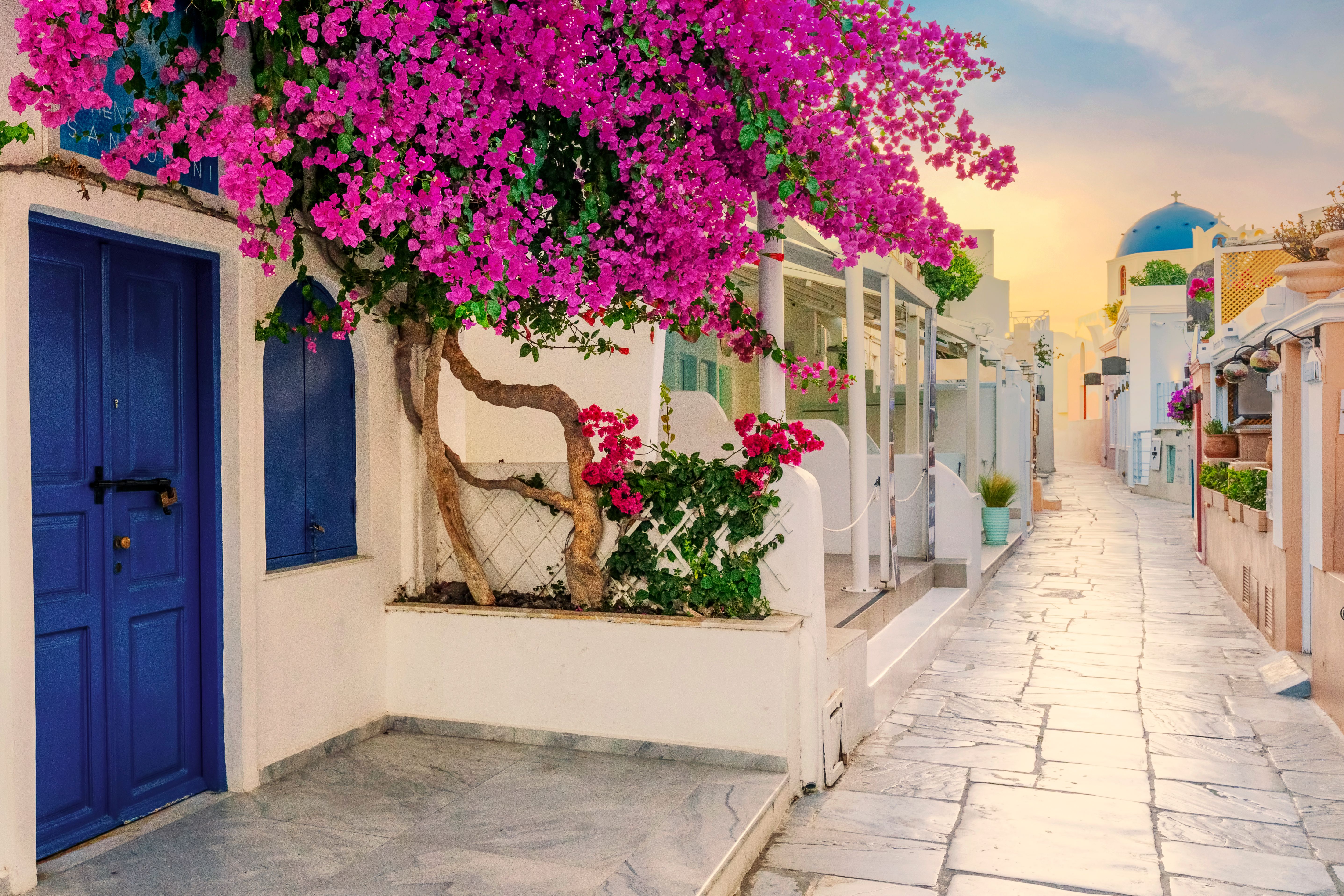Travelling from Rhodes to Thira (Santorini): Complete Ferry & Travel Guide
Travel Guides
Travel Guides


The journey from Rhodes to Thira (Santorini) connects two of Greece's most stunning islands, offering travellers a chance to experience the diverse beauty of the Aegean Sea. This popular route spans approximately 311.6 km (193.6 miles) across the sparkling Mediterranean waters. While flying between these destinations is possible during certain seasons, many travellers opt for the scenic ferry journey to fully appreciate the island-hopping experience. This comprehensive guide covers everything you need to know about travelling from Rhodes to Santorini, with a focus on ferry options, port information, and making the most of your visit to the iconic volcanic island of Santorini.
When planning your journey from Rhodes to Santorini, you have two main transportation options: by air or by sea. Each offers a different travel experience and comes with its own set of considerations.
The ferry route from Rhodes to Thira (Santorini) covers approximately 168.3 nautical miles across the Aegean Sea. Ferry journeys typically take around 17 hours and 33 minutes on average, making this a significant sea voyage. The good news is that ferries on this route offer comfortable amenities to ensure a pleasant journey despite the duration.
Blue Star Ferries operates the fastest service on this route, with journey times of approximately 11 hours and 40 minutes. This represents a considerable time saving compared to the longest duration of 22 hours and 20 minutes that some services might take. Ticket prices for the ferry journey average around £73, offering good value considering the distance covered and the experience of sailing through the Greek islands.
While flights between Rhodes and Santorini might be quicker, the ferry journey offers unique advantages. You'll have the opportunity to see multiple Greek islands from the water, experience the authentic maritime culture of the region, and arrive in Santorini in a more relaxed state of mind. The ferry also allows you to bring more luggage without strict weight restrictions and can be more economical, especially when travelling with family or in a group.
You can take a ferry from Rhodes to Thira (Santorini). Ferries sail in around 17 hours and 33 minutes with about 1 sailing per day. The fastest ferry sails in around 11 hours and 40 minutes and is provided by Blue Star Ferries. Ferry prices average around £73 for a standard foot passenger ticket. Departures start as early as 07:00, with the last departure from Rhodes to Thira (Santorini) at 16:00.
Blue Star Ferries is the primary operator serving this route, known for their reliable service and comfortable vessels. Their ferries are well-equipped with amenities to make your journey enjoyable despite the lengthy crossing time. On board, you can expect to find restaurants, cafes, shops, comfortable seating areas, and various cabin options for overnight journeys.
The ferries operating between Rhodes and Santorini are large, modern vessels designed for long-distance sea travel. Most ships offer both indoor and outdoor seating areas, allowing you to enjoy the sea breeze and spectacular views or retreat to air-conditioned comfort inside. Premium seating options and private cabins are available for those seeking extra comfort during the journey.
It's worth noting that this route operates year-round, with approximately 9 sailings per month. However, there may be more frequent services during the peak summer season (June to September) and reduced schedules during the winter months. We recommend booking your ferry tickets in advance, especially if you're travelling during the high season or planning to take your vehicle.
The ferry departure times are designed to maximise convenience, with morning departures allowing you to arrive in Santorini by the evening or early next morning. This schedule works well for travellers who want to maximise their time on both islands.

Rhodes ferry port is located in Rhodes Town, on the northeastern tip of the island. The main commercial port, where ferries to Santorini depart, is situated approximately 1 km from the medieval Old Town, making it easily accessible for most visitors staying in the main tourist areas.
To reach the port, you have several options. Taxis are readily available throughout Rhodes Town and can take you directly to the ferry terminal. If you're staying further away, KTEL buses connect major towns and resorts to Rhodes Town, from where you can take a short taxi ride or walk to the port. For those with rental cars, there are parking facilities near the port, though spaces can be limited during peak season.
The ferry terminal itself offers basic amenities including waiting areas, ticket offices (though we recommend booking in advance), restrooms, and a few cafes and kiosks for last-minute snacks or drinks. It's advisable to arrive at least 60 minutes before your scheduled departure time to allow for boarding procedures, especially if you're travelling with a vehicle.
Rhodes port is well-organised with clear signage, and port staff are usually available to direct passengers to the correct departure points. The Blue Star Ferries vessels are large and easily identifiable.
Arriving in Santorini, your ferry will dock at Athinios Port (also called the New Port), which is located on the southwest coast of the island, approximately 8 km from Fira, the island's capital. The port is built into the caldera cliffs, creating a dramatic arrival experience as you approach the island.
From Athinios Port, you have several transportation options to reach your accommodation. Taxis are available at the port, though they can be in high demand when multiple ferries arrive simultaneously. Pre-arranging a transfer through your hotel is often a good idea. Public buses run from the port to Fira, from where you can connect to other parts of the island. The bus schedule is typically coordinated with ferry arrivals, but delays can occur during peak season.
If you're renting a car in Santorini, many companies offer pickup services at the port or have offices nearby. Having your own vehicle can be convenient for exploring the island, though parking in popular areas can be challenging during high season.
The port facilities at Athinios are basic but functional, with a few cafes, travel agencies, and car rental offices. The port area can become quite busy and congested when ferries arrive, so it's best to have your onward transportation arranged in advance if possible.
Given the substantial ferry journey time of at least 11 hours and 40 minutes between Rhodes and Santorini, a day trip between these two islands is unfortunately not feasible. The distance and travel time make it impractical to visit Santorini from Rhodes and return on the same day.
For those interested in experiencing both islands, we recommend planning a stay of at least 2-3 nights in Santorini as part of your Greek island-hopping itinerary. This allows you to properly explore Santorini's unique landscape, visit its famous villages like Oia and Fira, experience a spectacular sunset, and perhaps take a boat tour of the caldera.
A more realistic approach would be to spend several days on Rhodes, then take the ferry to Santorini for another few days before either returning to Rhodes or continuing your journey to other destinations. This way, you'll have enough time to appreciate the distinct character and attractions of both islands without feeling rushed.
If you're specifically interested in day trips from Rhodes, consider visiting closer islands such as Symi, Chalki, or even Kos, which are more accessible for single-day excursions. These beautiful neighbouring islands can be reached with much shorter ferry journeys, making them perfect for day trips while using Rhodes as your base.
Santorini offers some of the most spectacular scenery in the Greek islands, with plenty of activities to fill your itinerary:
Oia Sunset - Perhaps the most famous attraction in Santorini, watching the sunset from the village of Oia is an unforgettable experience. The white buildings with blue domes against the backdrop of the setting sun create a magical atmosphere. Arrive early to secure a good viewing spot, as this attraction draws crowds year-round.
Akrotiri Archaeological Site - Often called the Greek Pompeii, this remarkably preserved ancient Minoan settlement was buried under volcanic ash around 1600 BCE. Open daily from 8:00 to 20:00 in summer (shorter hours in winter), it offers fascinating insights into prehistoric life.
Caldera Boat Tour - Seeing Santorini from the water provides a unique perspective of the island's dramatic cliffs and volcanic features. Many tours include stops at the hot springs, the volcano, and Thirassia island, with some offering swimming opportunities and meals on board.
Ancient Thera - Located on Mesa Vouno mountain, this ancient city offers both historical interest and spectacular views. The site features ruins from the Hellenistic, Roman, and Byzantine periods and is open Tuesday through Sunday from 8:30 to 15:30.
Wine Tasting - Santorini's unique volcanic soil produces distinctive wines, particularly the crisp white Assyrtiko. The island boasts numerous wineries offering tours and tastings, with Santo Wines and Domaine Sigalas being among the most popular.

Santorini's charm extends beyond its famous caldera views, with several distinct areas worth exploring:
Fira, the island's capital, offers a blend of shopping, dining, and nightlife along with spectacular caldera views. Its central location makes it an excellent base for exploring the island, and it's where you'll find many of the island's museums and cultural attractions.
Imerovigli, known as the balcony to the Aegean, sits at the highest point of the caldera edge, offering perhaps the most stunning views on the island. This quieter village is perfect for those seeking a more relaxed atmosphere while still enjoying premium vistas.
Kamari and Perissa feature Santorini's famous black sand beaches, with organised beach facilities, water sports, and a more relaxed, resort-like atmosphere compared to the caldera villages. These areas offer a different side of Santorini and generally more affordable accommodation options.
For authentic local experiences, venture to villages like Megalochori or Pyrgos, where you can wander through traditional settlements with charming architecture, local tavernas, and fewer tourists.
Santorini enjoys a Mediterranean climate with long, hot summers and mild, sometimes rainy winters. The peak summer months of July and August see average temperatures between 23°C and 29°C, with virtually no rainfall and abundant sunshine. These conditions are perfect for beach activities and exploring the island, though they also bring the largest crowds and highest prices.
Spring (April to June) and autumn (September to October) offer ideal conditions for visiting Santorini, with pleasant temperatures ranging from 15°C to 25°C, fewer crowds, and more affordable accommodation. These shoulder seasons provide excellent conditions for hiking, sightseeing, and photography.
Winter in Santorini (November to March) is mild compared to northern Europe, with temperatures typically between 10°C and 15°C. This period sees more rainfall and some businesses close for the season, but the island takes on a peaceful, authentic character that appeals to travellers seeking a more local experience.
Weather conditions can occasionally affect ferry operations, particularly during the winter months when strong winds in the Aegean can cause delays or cancellations. Blue Star Ferries' larger vessels are generally more reliable in adverse weather conditions than smaller, high-speed craft, but it's always advisable to have some flexibility in your travel plans during the off-season.
Santorini is considered one of the more expensive Greek islands, particularly in the premium caldera-view areas of Oia, Imerovigli, and Fira. However, with careful planning, it's possible to visit on various budgets.
A budget traveller might spend around £60-100 per day, staying in hostels or budget hotels away from the caldera, eating at gyros shops and local tavernas, and using public transportation. Mid-range travellers should budget approximately £150-250 per day for comfortable hotels, good restaurants, and some activities or tours.
For luxury experiences including caldera-view suites, fine dining, private tours, and wine tastings, expect to spend £300+ per day. Accommodation with infinity pools and sunset views commands premium prices, especially during high season.
To save money, consider visiting during shoulder season (May-June or September-October), when you'll find better deals while still enjoying good weather. Staying in villages like Karterados, Messaria, or the beach areas of Kamari and Perissa can significantly reduce accommodation costs compared to the caldera villages.
Sample costs include: a gyros wrap (£3-5), a meal at a mid-range taverna (£15-25 per person), a local beer (£3-5), a caldera sunset cruise (£35-80), and public bus tickets (£1.50-2.50 per journey).
The ideal time to visit Santorini depends on your priorities regarding weather, crowds, and budget. The peak season from late June through early September offers guaranteed sunshine and warm temperatures perfect for swimming and sunbathing. However, this period also brings crowded attractions, higher prices, and the need to book accommodations and restaurants well in advance.
The shoulder seasons of late April to early June and late September to October represent the sweet spot for many visitors. During these periods, you'll enjoy pleasant temperatures suitable for sightseeing and hiking, fewer crowds at major attractions, and more reasonable prices. The sea remains warm enough for swimming, especially in early autumn when it retains summer heat.
Winter visits (November through March) offer a completely different experience of Santorini. While some businesses close and the weather can be unpredictable, you'll discover a more authentic island lifestyle, dramatically lower prices, and the luxury of having normally crowded viewpoints almost to yourself. Photography enthusiasts particularly appreciate the winter light and moody skies over the caldera.
Notable events include the Santorini Jazz Festival in July, the International Music Festival in September, and Orthodox Easter celebrations (dates vary), which can add a cultural dimension to your visit. The grape harvest in late August and September is also an interesting time to visit if you're interested in the island's winemaking traditions.

Finding the perfect accommodation in Santorini can enhance your Greek island experience after arriving by ferry from Rhodes. The island offers a range of options to suit all budgets and preferences.
For travellers watching their spending, areas like Karterados and Messaria offer more affordable accommodation while still being conveniently located. Hostels in Fira start from around £30 per night, while budget guesthouses across the island typically range from £40-70 per night depending on the season.
Couples seeking romantic settings should consider boutique hotels in Imerovigli or Firostefani, where you can enjoy stunning caldera views without Oia's premium prices (expect to pay £100-200 per night). Families might prefer the spacious apartments in Kamari or Perissa, which offer beachfront locations and family-friendly amenities from £80-150 per night.
For an authentic experience, consider traditional cave houses converted into holiday rentals, particularly in villages like Emporio or Megalochori.
After your ferry journey from Rhodes docks at Athinios Port, you'll need to navigate your way around the island.
The KTEL bus network is surprisingly efficient and affordable (tickets cost £1.50-2.50 per journey), connecting most major towns and beaches. Buses run frequently during summer months, though schedules reduce significantly in winter.
Renting a vehicle gives you the freedom to explore Santorini's hidden corners. Quad bikes and scooters are popular choices (from £25 per day), though a small car (from £40 per day) offers more comfort and safety on the winding roads. Many visitors rent vehicles just for 1-2 days of exploration rather than their entire stay.
Taxis are available but limited in number and can be expensive during peak season, with a journey from the port to Fira costing approximately £20-25.
The journey from Rhodes to Santorini by ferry offers a wonderful opportunity to experience two of Greece's most beloved islands in one trip. With Blue Star Ferries providing the fastest crossing at 11 hours 40 minutes for around £73, the sea journey becomes part of your holiday adventure rather than just a transfer.
Remember that with just one daily sailing and limited weekly departures (approximately 9 sailings per month), booking your ferry tickets in advance is essential, especially during the summer months when demand is highest.
Whether you're drawn to Rhodes' mediaeval history or Santorini's iconic white-washed buildings and blue domes, this island-hopping route delivers an unforgettable Greek experience. We recommend planning at least 3-4 days in Santorini to fully appreciate its unique landscape, volcanic beaches, and world-famous sunsets after your ferry arrival from Rhodes.
Ready to embark on your Rhodes to Santorini adventure? Book your ferry tickets today and prepare for an incredible journey across the Aegean Sea!